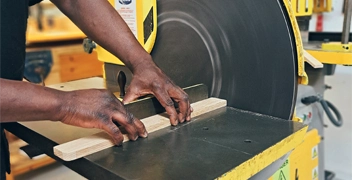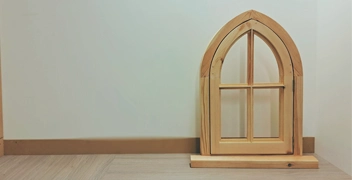Fitted Interiors
Apprenticeship Level 2
| Occupations | |
|---|---|
| Fitted Interiors Installer | ✔ |
| Interior Fit-out technician | ✔ |
| Shop Fitter | ✔ |
| Exhibition Stand Fitter | ✔ |
| Level | |
|---|---|
| Level 2 - equivalent to GCSE | ✔ |
| Essential workplace skills | ✔ |
| Vocational skills | ✔ |
| Training Locations | |
|---|---|
| Employer's manufacturing facility | ✔ |
| Woodwise Academy, Bristol | Block Release |
| Getting started | |
|---|---|
| January, May & September | Starts |
| Training places subject to caseload capacity | Please enquire |
| Geographic locations - some restrictions apply | Please enquire |
| Training Access & Support | |
|---|---|
| Access Didac's eLearning Portal | ✔ |
| One-to-one training sessions | ✔ |
| Regular reviews with your trainer and employer | ✔ |
| ePortfolio - to record training & development | ✔ |
| Opportunities to improve your Maths & English skills | ✔ |
| Duration | |
|---|---|
| Minimum of 12 months, typically 15 to 18 months | ✔ |
| Funding - England | |
|---|---|
| Government Funding | ✔ |
| Funding Value | £11,000 |
| Employer Contributions | £1, 000 |
| Age grants for employers - England | |
|---|---|
| Under 19 Apprentice - 3 months | £500 |
| Under 19 Apprentice - 12 months | £500 |
| Apprenticeship Standard | |
|---|---|
| General Furniture Manufacturer - see page 10 | |
| Wales, Scotland & Northern Ireland | |
|---|---|
| Please contact us for commercial options | |
Fitted Interiors
Apprenticeship Level 2
Fitted interiors need a wide range of skills covering the preparation, installation and post installation phases of projects
Kitchens, bedrooms, bathrooms, offices, shops, exhibitions, boat interiors
A Fitted Interior is responsible for preparing and installing furniture including kitchens, bedrooms, bathrooms and offices, shops, exhibitions and boat interiors. Frequently this will take place onsite at the customer’s commercial or domestic premises.
Apprentices taking this route will experience a wide variety of projects and frequently interface closely with customers.
Whether you are leaving school, graduating or looking to change career to work with wood this is a great apprenticeship standard because it provides the knowledge and skills for all sorts of installation and fit-out occupations.
With Didac’s industrial experience, we can create training plans to cover specialised installation and fit-out settings.
Click the Add to Enquiry button below to find out more – it could be the best click you have ever made…
Specification
| Accreditation | |
|---|---|
| Delivery |
To meet the diverse requirements of the industry every apprentice will learn a wide range of skills in preparation, installation and post installation phases of projects.
Preparation
Transporting & Handling of Materials – Ensure the safe transportation and handling of installation equipment and materials.
Installation
Prepare Location – for assembly and placement of furniture. This involves making the assembly and placement area ready for work and preparing the furniture components for assembly.
Measure and Mark Out – materials to specification.
Power Tools & Hand Tools – set up and operate tools used to assemble furniture. Understand the tools used within the working area and which specific job they are used in.
Assemble – components of fitted furniture and understand the sequence of assembly and why this is important.
Install furniture on location to specification – this includes scribing, fixing and securing of furniture using correct fixings relating to the foundation being secured to etc., adaptations to non- standard situations to specification (i.e., pipe box, sockets, gas meter)
Post installation
Re-instate a Location – after assembly and placement of furniture. This involves confirming the end of the installation, ensuring all equipment, unused materials and waste is cleared while maintaining customer liaison.
Customer Service – develop customer relationships, including building customer confidence in the level of service provided, meeting the ongoing needs and expectations of customers and developing relationships between customers and your organisation.
Rectification Work – carry out rectification or rework, which could include changing hinges and handles. Identify snags and awareness of where to seek help and guidance.
You must:
- be 16 or over
- not already be in full-time education
- live in England to qualify for Didac funded apprenticeships
You can start an apprenticeship whether you’re starting your career, want a change or you’re upskilling in your current job. You can have a previous qualification like a degree and still start an apprenticeship.
As an apprentice you’ll:
- learn and train for a specific job
- get paid and receive holiday leave
- get hands-on experience in a real job
- be given the opportunity to improve your maths and English skills
- study for at least 20% of your working hours off-the-job
- complete assessments during and at the end of your apprenticeship
- be on a career path with lots of future potential

Polli Morrow
We hired Ray Fearon from DIDAC woodworking academy to come to our Men’s Shed to teach us safety in our workshop. He was an excellent instructor. Thorough, knowledgeable, approachable and a person one could approach to ask any question. We learnt a lot from him and going forward we are passing that information to our members.





